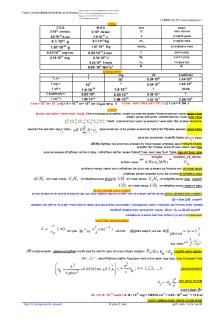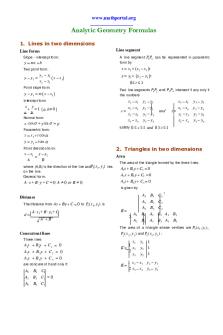Solid geometry formulas PDF

| Title | Solid geometry formulas |
|---|---|
| Course | Bachelor of Science in Civil Engineering |
| Institution | Technological University of the Philippines |
| Pages | 2 |
| File Size | 201.4 KB |
| File Type | |
| Total Downloads | 105 |
| Total Views | 131 |
Summary
formulas on solid geometry...
Description
Prepared by:
Plane and Solid Geometry Formulas ASIAN DEVELOPMENT FOUNDATION COLLEGE Tacloban City
The content of this material is one of the intellectual properties of Engr. Romel Tarcelo F. Verterra of Asian Development Foundation College. Reproduction of this copyrighted material without consent of the author is punishable by law.
Given four sides a, b, c, d, and sum of two opposite angles:
10 sides 11 sides 12 sides 15 sides 16 sides
A= (s −a)(s − b)(s − c)(s − d) − abcdcos2 θ a + b+ c + d 2 ∠ A + ∠C ∠B + ∠D θ= or θ = 2 2
s=
Parallelogram
Number of diagonals, D The diagonal of a polygon is the line segment joining two non-adjacent sides. The number of diagonals is given by: n D = (n − 3) 2
C d1
d2
θ
b
D a Given diagonals d1 and d2 and included angle θ: A = ½ d 1 × d2 × sin θ
PLANE AREAS
Given two sides a and b and one angle A:
B
A = ab sin A Rhombus
C
D d1
θ
C
A B
Given base b and altitude h A = ½ bh
s=
a
A = ½ d 1 × d2
a+b 2
h h
b
Area =
C c d1 D
d2 a d A
( s − a)(s − b)( s − c)(s − d)
a + b+ c + d 2
s=
“For any cyclic quadrilateral, the product of the diagonals equals the sum of the products of the opposite sides” d1 × d2 = ac + bd
Perimeter, P = 2(a + b) Diagonal, d = a 2 + b 2
d
There are two basic types of polygons, a convex and a concave polygon. A convex polygon is one in which no side, when extended, will pass inside the polygon, otherwise it called concave polygon. The following figure is a convex polygon. β4 θ4 β3
a
Perimeter, P = 4a a
Diagonal, d = a 2 General quadrilateral b
C
B
β5
d1
β2
d2 D
A
θ5
θ3
c
θ
d
Given diagonals d1 and d2 and included angle θ:
A = ½ d 1 × d2 × sin θ
θ2 θ1
β1
= = = =
A circle is escribed about a triangle if it is tangent to one side and to the prolongation of the other two sides. A triangle has three escribed circles.
c a
AT s− a
AT
; rc =
s−c
Arc C = r × θradians =
πrθ 180°
Area = ½ r 2 θradians =
πr 2θ 360 °
A circle is circumscribed about a quadrilateral if it passes through the vertices of the quadrilateral.
b r
C
θ
r
d
(ab + cd)(ac + bd)(ad + bc ) 4 Aquad (s − a)( s − b)(s − c)(s − d)
r
Circle incribed in a quadrilateral b A circle is inscribed in a quadrilateral r if it is tangent to the three a sides of the quadrilateral.
c
O
C
Area = Asect or – At riangle Area = ½ r 2 θr – ½ r 2 sin θ Area = ½ r 2 (θr – sin θ)
s
d ;
s = ½(a + b + c + d)
abcd
SOLID GEOMETRY
α = 360 - θ r r θ
2 bh 3
A quad
r
O
Area = Asect or + At riangle Area = ½ r 2 αr + ½ r 2 sin θ Area = ½ r 2 (αr + sin θ)
r=
Aquad =
θ
r
θr = angle in radians
POLYHEDRONS
A polyhedron is a closed solid whose faces are polygons.
h
Ellipse
b
Area = π a b Perimeter, P
P = 2π
c
a
D
Segment of a circle
Area =
s −b
Circle circumscribed about a quadrilateral
r=
r
AT
; rb =
Circumference = 2π r = πD π 2 D Area, A = π r 2 = 4
β6
triangle quadrangle or quadrilateral pentagon hexagon
ra =
Aquad =
θ6
Polygons are classified according to the number of sides. The following are some names of polygons. 3 sides 4 sides 5 sides 6 sides
Circles escribed about a triangle (Excircles)
s = ½(a + b + c + d)
Parabolic segment
C
b
Note: 1 radian is the angle θ such that C = r.
Square
Area, A = a2
r
Circle
Area = ½ C × r POLYGONS
r
b
ra
Perimeter, P = n × x n− 2 × 180° Interior angle = n Exterior angle = 360° / n
Ptolemy’s theorem
a r
ra
Sector of a circle
b
c
A
x
Area, A = ½ R2 sin θ × n = ½ x r × n
B
∠A + ∠C = 180° ∠B + ∠D = 180°
AT s s = ½(a + b + c)
ra
θ = 360° / n
b
A cyclic quadrilateral is a quadrilateral whose vertices lie on the circumference of a circle.
Circle inscribed in a triangle (Incircle) A circle is inscribed in a triangle if it is tangent to the three sides of the triangle. B Incenter of the triangle
Inscribed circle
x = side θ = angle subtended by the side from the center R = radius of circumscribing circle r = radius of inscribed circle, also called the apothem n = number of sides
a
Cyclic Quadrilateral
Rectangle
a
c b
abc r= 4A T
x
Trapezoid
The area under this condition can also be solved by finding one side using sine law and apply the formula for two sides and included angle.
d
R R θ θ θ θ θ Apothem
A = a 2 sin A
A=
a 2 sinB sinC A= 2 sin A
x
Given side a and one angle A:
2
Given three angles A, B, and C and one side a:
a
x
r
s (s − a)(s − b)(s − c )
Area, A = ab
Polygons whose sides are equal are called equilateral polygons. Polygons with equal interior angles are called equiangular polygons. Polygons that are both equilateral and equiangular are called regular polygons. The area of a regular polygon can be found by considering one segment, which has the form of an isosceles triangle. Circumscribing x circle x
A
a
a + b+ c
The area under this condition can also be solved by finding one angle using cosine law and apply the formula for two sides and included angle.
r
a
r=
Regular polygons
Given diagonals d1 and d2:
Given two sides a and b and included angle θ: A = ½ ab sin θ
A=
d2
90°
b
Given three sides a, b, and c: (Hero’s Formula)
Circumcenter of the triangle
AT = area of the triangle
PLANE GEOMETRY
h
A circle is circumscribed about a triangle if it passes through the vertices of the triangle.
A = ½ ab sin B + ½ cd sin D
A
a
Circle circumscribed about a triangle (Cicumcircle)
Sum of exterior angles The sum of exterior angles β is equal to 360°. ∑β = 360°
Divide the area into two triangles
B
c
RADIUS OF CIRCLES
decagon undecagon dodecagon quindecagon hexadecagon
Sum of interior angles The sum of interior angles θ of a polygon of n sides is: Sum, Σθ = (n – 2) × 180°
Given four sides a, b, c, d, and two opposite angles B and D:
Part of: Plane and Solid Geometry by RTFVerterra © October 2003
Triangle
= = = = =
RTFV e rte rra
a 2 + b2
PRISM
a
b b
a
A prism is a polyhedron whose bases are equal polygons in parallel planes and whose sides are
7 sides 8 sides 9 sides
= heptagon or septagon = octagon = nonagon
2
parallelograms. Prisms are classified according to their bases. Thus, a hexagonal prism is one whose base is a...
Similar Free PDFs

Solid geometry formulas
- 2 Pages

Tumws 20VDA-Formulas - Formulas
- 5 Pages

Formulas
- 2 Pages

SOLID FUELS
- 92 Pages

125001-Formulas - formulas sheet
- 8 Pages

Formulas
- 6 Pages

Formulas
- 1 Pages

Formulas
- 2 Pages

Instalación solid
- 7 Pages

Geometry - Audin
- 365 Pages

Digital geometry
- 5 Pages
Popular Institutions
- Tinajero National High School - Annex
- Politeknik Caltex Riau
- Yokohama City University
- SGT University
- University of Al-Qadisiyah
- Divine Word College of Vigan
- Techniek College Rotterdam
- Universidade de Santiago
- Universiti Teknologi MARA Cawangan Johor Kampus Pasir Gudang
- Poltekkes Kemenkes Yogyakarta
- Baguio City National High School
- Colegio san marcos
- preparatoria uno
- Centro de Bachillerato Tecnológico Industrial y de Servicios No. 107
- Dalian Maritime University
- Quang Trung Secondary School
- Colegio Tecnológico en Informática
- Corporación Regional de Educación Superior
- Grupo CEDVA
- Dar Al Uloom University
- Centro de Estudios Preuniversitarios de la Universidad Nacional de Ingeniería
- 上智大学
- Aakash International School, Nuna Majara
- San Felipe Neri Catholic School
- Kang Chiao International School - New Taipei City
- Misamis Occidental National High School
- Institución Educativa Escuela Normal Juan Ladrilleros
- Kolehiyo ng Pantukan
- Batanes State College
- Instituto Continental
- Sekolah Menengah Kejuruan Kesehatan Kaltara (Tarakan)
- Colegio de La Inmaculada Concepcion - Cebu




